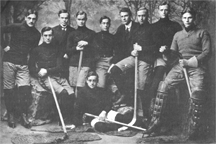

1908-1913 Ligue Internationale de Hockey sur Glace On 15/16 May 1908 delegates from ice hockey officials from four countries met in Paris upon the invitation of the French journalist Louis Magnus: Planque and van der Hoeven (France), de Clercq and Malaret (Belgium), Mellor and Dufour (Switzerland) as well as Mavrogrodato (Great Britain). Following a thorough debate, they established the "Ligue Internationale de Hockey sur Glace" (LIHG) and chose Magnus as President as well as Louis Planque as General Secretary. Representatives from Russia and Germany, who had also been invited, did not attend. France (20.10.), Bohemia (15.11.), Great Britain (19.11.), Switzerland (23.11.), and Belgium (8.12.), became members already in the foundation year.
Between 22 and 25 January 1909, the second congress of the federation took place in Chamonix. On that occasion, the LIHG established its own playing and competition rules and decided to organize annual European championships starting from the following year. In conjunction with the congress, a „International City Tournament" was played in Chamonix, and the winning city was London. On 19 September 1909, Germany was adopted as the sixth member of the LIHG.
The first European championship was played from 10 to 12 January 1910 in Les Avants near Montreux (Switzerland) with four "official" participants – Great Britain, Germany, Belgium, and Switzerland – plus the "Oxford Canadiens", a team of Canadians studying in Oxford who competed as a non-official competitor. Starting from then, European championships took place on a regular basis – interrupted only during the years of the war – at first as an event of its own and from 1930 onwards in conjunction with the world championships. Between 1912 and 1914, beside the European championship, a so-called "LIHG championship" involving national teams was organized every year, however, this competition did not gain much importance.
On 9 January 1910, the day before the start of the first European Championship, the delegates of the member associations met in Montreux for the 3rd congress of the federation. The congress re-elected Magnus as the President, and the Briton Patton was appointed Vice President. General Secretary Planque was reconfirmed in his position. In Berlin, the venue of the second European championship, the 4th congress of the federation took place on 16/17 February 1911. The congress adopted Russia as the 7th member of the LIHG, and Patton was replaced as Vice President by Hermann Kleeberg (Germany). Against the previous practice, the 5th congress of the federation did not take place at the time and the venue of the European championship. Whereas the championship was played in Prague from 2 to 4 February 1912, the congress participants met in Brussels on 22/23 March.
To start with, they had to master a difficult issue, namely the decision regarding a protest by Germany against the result of the European championship (Bohemia winning before Germany and Austria). In the end, the result was cancelled because Austria at the time of the competition had not yet been member of the LIHG. Austria was subsequently adopted in the LIHG in Brussels together with Sweden and Luxembourg. A few changes were made in the federation Council: the Belgian Henri van den Bulcke replaced Louis Magnus as President, Max Sillig (Switzerland) succeeded Hermann Kleeberg as Vice President, and the Belgian van der Straten-Ponthoz replaced the former office holder Planque as General Secretary. At the 6th LIHG congress in St. Moritz, there was again a change in the leadership. Sillig withdrew after only a one year’s function from the position as Vice President, which was taken over again by the Briton Patton. |






